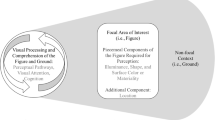Abstract
In this paper, we propose an efficient algorithm for illuminant estimation. The 2D estimator is derived based on the maximal projections’ mean assumption according to which the estimated illuminant in a chromaticity subspace is the vector maximizing the sum of orthogonal projections of image colors. We show that, the illuminant estimation solution is the eigenvector corresponding to the maximal eigenvalue of the inner-product matrix of data. The 2D estimator is extended to the 3D space by minimizing the reconstruction errors from the 2D estimates obtained in the RGB color space. The evaluation of the 3D resulting estimator on three well-known image datasets generates lower estimation errors.









Similar content being viewed by others
References
Barnard K, Martin L, Funt B, Coath A (2002) A data set for color research. Color Res Appl 27(3):147–151
Barrow HG, tenenbaum JM (1978) Recovering intrinsic scene characteristics from images. Computer vision systems
Bianco S, Schettini R (2012) Face-based illuminant estimation. In: European Conference on Computer Vision, pp 623–626. Springer
Brainard DH, Freeman WT (1997) Bayesian color constancy. JOSA A 14 (7):1393–1411
Buchsbaum G (1980) A spatial processor model for object colour perception. Journal of the Franklin institute 310(1):1–26
Cardei VC, Funt B (1999) Committee-based color constancy. In: Color and Imaging Conference, volume 1999, pp 311–313. Society for Imaging Science and Technology
Cardei Vlad C, Funt B, Kobus B (2002) Estimating the scene illumination chromaticity by using a neural network. JOSA A 19(12):2374–2386
Chakrabarti A, Hirakawa K, Zickler T (2008) Color constancy beyond bags of pixels. In: 2008 IEEE Conference on Computer Vision and Pattern Recognition, 2008. CVPR, pp 1–6. IEEE
Ciurea F, Funt B (2003) A large image database for color constancy research. In: CIC, volume 2003, pp 160–164. Society for Imaging Science and Technology
Drew MS, Joze HRV, Finlayson GD (2014) The zeta-image, illuminant estimation, and specularity manipulation. Comput Vis Image Underst 127:1–13
Elkhamssa L, Djemel Z (2016) Computer vision color constancy from maximal projections mean assumption. In: International Conference on Image and Signal Processing, Springer, pp 148–156
Finlayson GD, Schaefer G (2001) Solving for colour constancy using a constrained dichromatic reflection model. IJCV 42(3):127–144
Finlayson GD, Trezzi E (2004) Shades of gray and colour constancy, pp 37–41
Finlayson GD, Hordley SD, Hubel PM (2001) Color by correlation: A simple, unifying framework for color constancy. IEEE Trans PAMI 23(11):1209–1221
Finlayson GD, Drew MS, Lu C (2004) Intrinsic images by entropy minimization. In: Comp. Vis.-ECCV 2004, pp 582–595. Springer
Finlayson GD, Hordley SD, Tastl I (2006) Gamut constrained illuminant estimation. IJCV 67(1): 93–109
Forsyth DA (1990) A novel algorithm for color constancy. IJCV 5(1):5–35
Funt B, Xiong W (2004) Estimating illumination chromaticity via support vector regression. In: Color and Imaging Conference, volume 2004, pp 47–52. Society for Imaging Science and Technology
Gehler PV, Rother C, Blake A, Minka T, Sharp T (2008) Bayesian color constancy revisited. In: IEEE Conference on CVPR, 2008. CVPR 2008, pp 1–8. IEEE
Gijsenij A, Gevers T (2007) Color constancy using natural image statistics. In: CVPR, pp 1–8
Gijsenij A, Gevers T (2011) Color constancy using natural image statistics and scene semantics. IEEE Trans PAMI 33(4):687–698
Gijsenij A, Gevers T, Weijer JVD (2009) Physics-based edge evaluation for improved color constancy. In: CVPR, pp 581–588
Gijsenij A, Gevers T, Weijer JVD (2011) Computational color constancy: Survey and experiments. Im Proc IEEE Trans 20(9):2475–2489
Gijsenij A, Rui L, Gevers T (2012) Color constancy for multiple light sources. IEEE Trans Image Process 21(2):697–707
Healey G (1989) Using color for geometry-insensitive segmentation. JOSA A 6 (6):920–937
Healey G (1991) Estimating spectral reflectance using highlights. Image Vis Comput 9(5):333– 337
Hordley SD (2006) Scene illuminant estimation: past, present, and future. Color Res Appl 31(4):303–314
Huttenlocher DP, Klanderman GA, Rucklidge WJ (1993) Comparing images using the hausdorff distance. IEEE Trans Pattern Anal Mach Intell 15(9):850–863
Jenssen R (2013) Mean vector component analysis for visualization and clustering of nonnegative data. IEEE Trans NNLS 24(10):1553–1564
Joze HRV, Drew MS, Finlayson GD, Rey PAT (2012) The role of bright pixels in illumination estimation. In: CIC, volume, pp 41–46
Kerouh F, Ziou D, Lahmar KN (2016) Content Based Computational chromatic adaptation. In: IVAPP- Lecture notes in Computer Sciences
Land EH (1977) The retinex theory of color vision. Scientific America
Lee HC (1986) Method for computing the scene-illuminant chromaticity from specular highlights. JOSA A 3(10):1694–1699
Lee Hee C, Breneman EJ, Schulte CP (1990) Modeling light reflection for computer color vision. IEEE Trans Pattern Anal Mach Intell 12(4):402–409
MacAdam DL (1956) Chromatic adaptation. JOSA 46(7):500–513
Mazin B, Delon J, Gousseau Y (2015) Estimation of illuminants from projections on the planckian locus. IEEE Trans Image Process 24(6):1944–1955
Nouha E, Theo G, Arjan G, Jordi G (2014) Color constancy using 3d scene geometry derived from a single image. IEEE Trans Image Process 23(9):3855–3868
Pillai U, Suel T, Cha S (2005) The perron-frobenius theorem: some of its applications. IEEE Signal Process Mag 22(2):62–75
Phong BT (1975) Illumination for computer generated pictures. Commun ACM 18(6):311–317
Rosenberg C, Ladsariya A, Minka T (2003) Bayesian color constancy with non-gaussian models. In: Advances in neural information processing systems
Rui L, Gijsenij A, Gevers T, van KEA, de Sande J-MG, Xu D (2009) Color constancy using stage classification. In: ICIP, pp 685–688
Rui L, Gijsenij A, Gevers T, Nedovic V, De X, Geusebroek J-M (2009) Color constancy using 3d scene geometry. In: 2009 IEEE 12th International Conference on Computer Vision, pp 1749–1756. IEEE
Schaefer G (2004) Robust dichromatic colour constancy. In: ICIAR, pp 257–264. Springer
Schaefer G, Hordley S, Finlayson G (2005) A combined physical and statistical approach to colour constancy. In: 2005 IEEE Computer Society Conference on Computer Vision and Pattern Recognition, 2005. CVPR, volume 1, pp 148–153. IEEE
Shafer SA (1985) Using color to separate reflection components. Color Res Appl 10(4):210–218
Shi L, Funt B (2008) Dichromatic illumination estimation via hough transforms in 3d. In: CGIV, volume, pp 259–262
Shi L, Funt B (2010) Re-processed version of the gehler color constancy dataset of 568 images. Simon Fraser Univ 1(2):3
Simone B, Raimondo S (2014) Adaptive color constancy using faces. IEEE Trans Pattern Anal Mach Intell 36(8):1505–1518
Tominaga S, Wandell BA (1989) Standard surface-reflectance model and illuminant estimation. JOSA A 6(4):576–584
Toro J (2008) Dichromatic illumination estimation without pre-segmentation. Pattern Recognit Lett 29(7):871–877
Vaezi Joze Hamid R, Drew M (2014) Exemplar-based colour constancy and multiple illumination. IEEE Trans Pattern Anal Mach Intell 36(5):860–873
von Kries J (1905) Die gesichtsempfindungen. Handbuch der physiologie des menschen
Weijer JVD, Gevers T, Gijsenij A (2007) Edge-based color constancy. IEEE Trans Image Process 16(9):2207–2214
Yoon K-J, Choi Y, Kweon IS (2006) Fast separation of reflection components using a specularity-invariant image representation. In: 2006 International Conference on Image Processing, pp 973–976. IEEE
Yuan X, Xiang F, Wang Z (2013) Improved gamut-constrained illuminant estimation by combining modified category correlation. Opt Rev 20(4):348–354
Author information
Authors and Affiliations
Corresponding author
Rights and permissions
About this article
Cite this article
Lakehal, E., Ziou, D. Computational color constancy from maximal projections mean assumption. Multimed Tools Appl 77, 20501–20517 (2018). https://doi.org/10.1007/s11042-017-5476-1
Received:
Revised:
Accepted:
Published:
Issue Date:
DOI: https://doi.org/10.1007/s11042-017-5476-1




